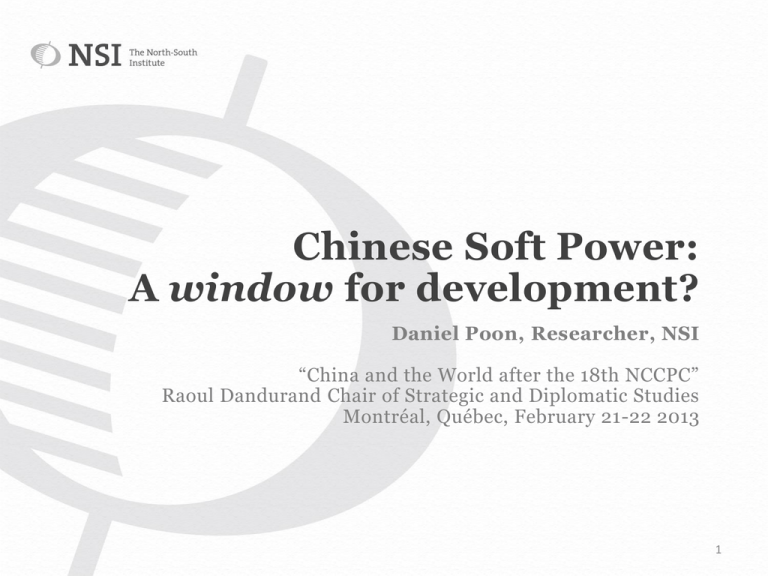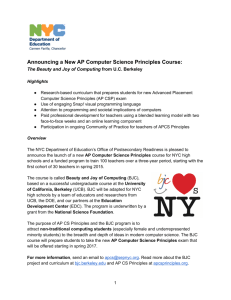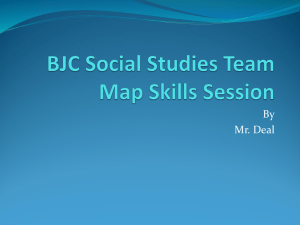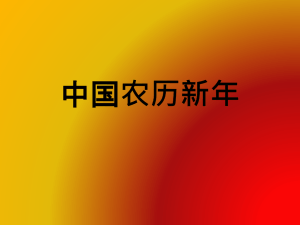Chinese Soft Power: a window for development? - The North
advertisement

Chinese Soft Power: A window for development? Daniel Poon, Researcher, NSI “China and the World after the 18th NCCPC” Raoul Dandurand Chair of Strategic and Diplomatic Studies Montréal, Québec, February 21-22 2013 1 Presentation Outline • Understanding the Beijing Consensus (BJC): Three perspectives • What’s unorthodox about China’s model of development? • China’s rise: a window for development? Burning Question: A transferable model? (to other developing countries) 2 Introduction Two broad approaches to economic reform ‘Shock Therapy’, Washington Consensus (WHC) Gradualism and pragmatism, Beijing Consensus (BJC) 3 Introduction Put Another Way Milton Friedman: “To cut the tail off the mouse, don’t do it inch-by-inch. To reduce the pain, the whole tail should be cut off at once.” Governor of Sichuan Province (1993): “My dear professor, our mouse has so many tails, we do not know which one to cut first.” 4 Understanding the BJC Three Perspectives Formerly a central banker with Bank Negara Malaysia and the Hong Kong Monetary Authority, Andrew Sheng argues that to thoroughly understand an issue, one needs to look at it from at least three levels: • From ‘30,000 feet’ up in order to understand the context and relativity of issues; • Then zoom down to ‘ground level’ to dig up the details; • But then slowly rise to ‘3,000 feet’ to get a much clearer macro-institutional perspective of the scale of the matter at hand. 5 Understanding the BJC From ‘30,000 feet’ Middle-Income Trap, Selected Countries, 1975-2010 Source: World Development Indicators 6 Understanding the BJC From ‘Ground Level’ Joshua Cooper Ramo (2004) • • • Innovation-based development combining tech fixes with institutional innovations; Economic performance not only measured by GDP growth, sustainability and equality also top priorities; Self-determination: globalization on China’s own terms, south-south soft power through economic heft, balance US security-related capabilities. Justin Lin (2008) China’s incremental and experimental strategies for economic reform and pragmatic and gradual liberalization have been unique and unorthodox. This approach has been piecemeal, partial, incremental and often experimental. It has not been guided by a well-founded theory or followed a pre-determined blueprint. John Williamson (2012) • • • Incremental reform, innovation, and experimentation Export-led growth (and accumulation of large volume of foreign currency reserves) Authoritarianism. 7 Understanding the BJC From ‘3,000 feet’ – Macro-Institutional Perspective El-Erian and Spence (2008) More accurate account of China’s approach to reform has been described as a form of “model uncertainty”, in which: • Leaders treat policy advice from advanced economy models with great caution, which instils a form of pragmatism in weighing risks, • Leads policy-makers to take gradual and experimental steps in areas such as the timing and sequencing of opening up the current and capital accounts, as well as in proceeding with export diversification. 8 China Model: Unorthodox? BJC at ‘3,000’ feet China’s broad strategic approach to development follows a wellworn path taken by most developed countries: • Like the East Asian tigers before it, China has violated “practically every rule in the guidebook.” (Rodrik 2001) • For example, “A notable feature of Asian-style globalization is that it has had a two-track nature: many import-competing activities have continued to receive support while new, export-oriented activities were spawned.” (McMillan and Rodrik 2011) • “Today’s China is the leading bearer of the mercantilist torch.” (Rodrik 2013) 9 China Model: Unorthodox? Re-Visiting the Impossible Trinity Chinese policy-makers have operated away from the ‘hard corners’ of the trinity, previously held to be best practice advice. • Orthodox configuration: open capital flows, floating exchange rate, independent monetary policy (inflation targeting) • Unorthodox configuration: degrees of capital account management, crawling peg exchange rate, degrees of monetary policy independence. • As per “model uncertainty”, this configuration shields the economy from volatile capital flows, while retaining greater degrees of interest and exchange rate independence to steer the economy. 10 1970 1971 1972 1973 1974 1975 1976 1977 1978 1979 1980 1981 1982 1983 1984 1985 1986 1987 1988 1989 1990 1991 1992 1993 1994 1995 1996 1997 1998 1999 2000 2001 2002 2003 2004 2005 2006 2007 2008 2009 Chinn-Ito Capital Account Openness Index China Model: Unorthodox? Sequencing Capital Account Opening Three Country Experiences, 1970-2009 (0 = Closed, 1 = Open) 0.8 0.7 0.6 0.5 0.4 0.3 0.2 0.1 0 South Korea China Bolivia 11 China Model: Unorthodox? Investment-led Growth (1) Source: Lardy 2006 12 China Model: Unorthodox? Investment-led Growth (2) The single area in which Chinese economic policy has diverged most consistently from the advice given to China by the IMF or the WB has been in the area of investment. Economists repeatedly warned the Chinese government that it was investing too much in the aggregate, and investing in inefficient or perhaps unnecessary projects that would turn out to have low rates of return. State-owned financial institutions were identified as the institutions facilitating frivolous and wasteful investments. The Chinese government, in practice, has consistently ignored these recommendations. … Yet China’s incredible growth in the 2000 decade has retrospectively validated this high investment policy. (Naughton 2010) 13 China Model: Unorthodox? Sectoral Industrial Policies: Renewable Energy Source: Dewey & LeBoeuf LLP (2010) 14 A window for development? A Different Partner? Trade Source: Financial Times and Standard Bank. 15 A window for development? A Different Partner? Investment/Loans Source: Financial Times. 16 A window for development? A Different Partner? Policy Approaches • China and other emerging economies do not insist on policy conditionality relating to what constitutes sound economic policy norms and practices. Instead, these countries generally engage in non-policy conditionality – such as tied-aid. • Anecdotally: China willing to invest in ‘un-economic’ projects. Ex: 2010 agreement to spend $23bn to build oil refineries and other infrastructure in Nigeria as part of China’s efforts to secure 6bn barrels of crude oil reserves. Nigeria, Africa’s leading energy producer, imports nearly all of its refined fuel, domestically subsidized at a cost of $4bn, equal to about the government’s entire capital spending budget. • Free trade agreements (FTAs): China’s bilateral FTAs generally focus more on WTO’s “old trade agenda” of market access. This is in contrast to the “new trade agenda” which is focused on deregulation, liberalization of services, investment, and stronger protection of intellectual property rights. (Wise 2012) • Not benevolence. China’s engagement abroad is an externalization of its own modernization experience of the past three decades (focus on investment in productive capacities, infrastructure, SEZs, role of state) = limited window. 17 A window for development? A Different Partner? One Point of View Ngozi Okonjo-Iweala, Finance Minister of Nigeria (2006) “China knows what it means to be poor, and has evolved a successful wealth creation formula that it is willing to share with African countries. … China provides an alternative viewpoint, a fresh approach that diversifies and enriches the spectrum of Africa’s interlocutors. For that reason, China should be left alone to forge its unique partnership with African countries and the West must simply learn to compete.” 18 THANK YOU! 谢谢您! The North-South Institute 55 Murray Street, Suite 500 Ottawa, Ontario Canada K1N 5M3 Tel.: (613) 241-3535 Fax: (613) 241-7435 Email/Courriel: dpoon@nsi-ins.ca Website: www.nsi-ins.ca The North-South Institute thanks the Canadian International Development Agency for its core grant and the International Development Research Centre for its program and institutional support grant to NSI. 19











